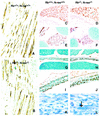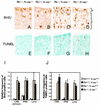Rb and N-ras function together to control differentiation in the mouse
- PMID: 12861012
- PMCID: PMC165732
- DOI: 10.1128/MCB.23.15.5256-5268.2003
Rb and N-ras function together to control differentiation in the mouse
Abstract
The product of the retinoblastoma tumor suppressor gene (Rb) can control cell proliferation and promote differentiation. Murine embryos nullizygous for Rb die midgestation with defects in cell cycle regulation, control of apoptosis, and terminal differentiation of several tissues, including skeletal muscle, nervous system, and lens. Previous cell culture-based experiments have suggested that the retinoblastoma protein (pRb) and Ras operate in a common pathway to control cellular differentiation. Here we have tested the hypothesis that the proto-oncogene N-ras participates in Rb-dependent regulation of differentiation by generating and characterizing murine embryos deficient in both N-ras and Rb. We show that deletion of N-ras rescues a unique subset of the developmental defects associated with nullizygosity of Rb, resulting in a significant extension of life span. Rb(-/-); N-ras(-/-) skeletal muscle has normal fiber density, myotube length and thickness, in contrast to Rb-deficient embryos. Additionally, Rb(-/-); N-ras(-/-) muscle shows a restoration in the expression of the late muscle-specific gene MCK, and this correlates with a significant potentiation of MyoD transcriptional activity in Rb(-/-); N-ras(-/-), compared to Rb(-/-) myoblasts in culture. The improved differentiation of skeletal muscle in Rb(-/-); N-ras(-/-) embryos occurs despite evidence of deregulated proliferation and apoptosis, as seen in Rb-deficient animals. Our findings suggest that the control of differentiation and proliferation by Rb are genetically separable.
Figures








Similar articles
-
Genetic interaction between Rb and K-ras in the control of differentiation and tumor suppression.Mol Cell Biol. 2004 Dec;24(23):10406-15. doi: 10.1128/MCB.24.23.10406-10415.2004. Mol Cell Biol. 2004. PMID: 15542848 Free PMC article.
-
MyoD induces apoptosis in the absence of RB function through a p21(WAF1)-dependent re-localization of cyclin/cdk complexes to the nucleus.Oncogene. 2002 Nov 21;21(53):8114-27. doi: 10.1038/sj.onc.1206010. Oncogene. 2002. PMID: 12444547
-
Selection of a dominant negative retinoblastoma protein (RB) inhibiting satellite myoblast differentiation implies an indirect interaction between MyoD and RB.Mol Cell Biol. 2000 Jul;20(14):5129-39. doi: 10.1128/MCB.20.14.5129-5139.2000. Mol Cell Biol. 2000. PMID: 10866669 Free PMC article.
-
Genetic interaction between Rb and N-ras: differentiation control and metastasis.Cancer Res. 2006 Oct 1;66(19):9345-8. doi: 10.1158/0008-5472.CAN-06-1250. Cancer Res. 2006. PMID: 17018584 Review.
-
pRb: master of differentiation. Coupling irreversible cell cycle withdrawal with induction of muscle-specific transcription.Oncogene. 2006 Aug 28;25(38):5244-9. doi: 10.1038/sj.onc.1209623. Oncogene. 2006. PMID: 16936743 Review.
Cited by
-
Wild-type NRas and KRas perform distinct functions during transformation.Mol Cell Biol. 2007 Oct;27(19):6742-55. doi: 10.1128/MCB.00234-07. Epub 2007 Jul 16. Mol Cell Biol. 2007. PMID: 17636015 Free PMC article.
-
The retinoblastoma gene pathway regulates the postmitotic state of hair cells of the mouse inner ear.Development. 2005 May;132(10):2377-88. doi: 10.1242/dev.01834. Epub 2005 Apr 20. Development. 2005. PMID: 15843406 Free PMC article.
-
Transient inactivation of Rb and ARF yields regenerative cells from postmitotic mammalian muscle.Cell Stem Cell. 2010 Aug 6;7(2):198-213. doi: 10.1016/j.stem.2010.05.022. Cell Stem Cell. 2010. PMID: 20682446 Free PMC article.
-
Let-7a regulates mammosphere formation capacity through Ras/NF-κB and Ras/MAPK/ERK pathway in breast cancer stem cells.Cell Cycle. 2015;14(11):1686-97. doi: 10.1080/15384101.2015.1030547. Cell Cycle. 2015. PMID: 25955298 Free PMC article.
-
Inhibition of oncogenic transformation by mammalian Lin-9, a pRB-associated protein.EMBO J. 2004 Nov 24;23(23):4627-38. doi: 10.1038/sj.emboj.7600470. Epub 2004 Nov 11. EMBO J. 2004. PMID: 15538385 Free PMC article.
References
-
- Bos, J. L. 1989. ras oncogenes in human cancer: a review. Cancer Res. 49:4682-4689. - PubMed
-
- Ceol, C. J., and H. R. Horvitz. 2001. dpl-1 DP and efl-1 E2F act with lin-35 Rb to antagonize Ras signaling in C. elegans vulval development. Mol. Cell 7:461-473. - PubMed
-
- Chen, P.-L., D. J. Riley, Y. Chen, and W.-H. Lee. 1996. Retinoblastoma protein positively regulates terminal adipocyte differentiation through direct interaction with C/EBPs. Genes Dev. 10:2794-2804. - PubMed
-
- Clarke, A. R., E. R. Maandag, M. van Roon, N. M. T. van der Lugt, M. van der Valk, M. L. Hooper, A. Berns, and H. te Riele. 1992. Requirement for a functional Rb-1 gene in murine development. Nature 359:328-330. - PubMed
Publication types
MeSH terms
Substances
Grants and funding
LinkOut - more resources
Full Text Sources
Molecular Biology Databases
Miscellaneous
